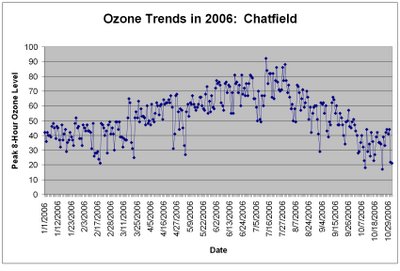Seasonal Ozone Trends in Denver
With cooler weather and less sunshine, ozone, or smog, levels in Denver have finally dropped to healthy levels. What are healthy levels of ozone? Well, according to the latest review from the Clean Air Scientific Advisory Committee, 8-hour ozone concentrations that exceed 60 parts per billion are unhealthy. Heeding this advice, we too feel that anytime 8-hour ozone concentrations in the Denver metro area exceed 60 parts per billion, our health is at risk.
It's striking to see how ozone levels trend in the Denver metro area by the seasons. Just looking at one monitor, the Chatfield monitor south of Denver, you can see how ozone levels are generally low in the fall and winter, then rise in the spring and summer. The chart below shows how peak 8-hour ozone concentrations have trended so far in 2006 at Chatfield.
 The seasonal trends in ozone are also striking in another way. Folks with the Colorado Air Pollution Control Division and especially the Regional Air Quality Council often claim that Denver's high ozone pollution is related to exceptional weather events, as if ozone pollution is a totally random occurrence. This makes no sense, especially when one looks at the chart above.
The seasonal trends in ozone are also striking in another way. Folks with the Colorado Air Pollution Control Division and especially the Regional Air Quality Council often claim that Denver's high ozone pollution is related to exceptional weather events, as if ozone pollution is a totally random occurrence. This makes no sense, especially when one looks at the chart above.Ozone in Denver clearly rises in the spring and summer, usually to unhealthy levels, and drops in the fall and winter. These trends are pretty clear, there really doesn't seem to be any relation between ozone and exceptional weather.
The only thing exceptional about Denver's ozone pollution is that we've allowed it to reach unhealthy levels, placing children and seniors at great risk.

0 Comments:
Post a Comment
<< Home